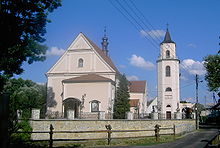Kielcza
| Kielcza | ||
|---|---|---|

|
|
|
| Basic data | ||
| State : | Poland | |
| Voivodeship : | Opole | |
| Powiat : | Strzelce Opolskie | |
| Gmina : | Zawadzkie | |
| Geographic location : | 50 ° 34 ' N , 18 ° 33' E | |
| Height : | 220 m npm | |
| Residents : | 1932 (March 31, 2011) | |
| Postal code : | 47-126 | |
| Telephone code : | (+48) 77 | |
| License plate : | EAST | |
| Economy and Transport | ||
| Street : | Droga wojewódzka 901 Olesno - Gliwice | |
| Next international airport : | Katowice | |
Kielcza (German: Keltsch ) is a street green village in Gmina Zawadzkie in the Polish Voivodeship of Opole . The Kielcza Schulzenamt has about 1930 inhabitants. The village leader is Cecylia Cieślik.
geography
It is located about 50 kilometers southeast of Opole and 50 kilometers northwest of Katowice , on the border with the Silesian Voivodeship . The district town of Strzelce Opolskie (German Groß Strehlitz) is about 18 kilometers away. The Malapane flows through the village . About 95 percent of the houses are at a level of about 8 to 10 meters above the river. During floods, such as in 1997 , only a few houses are affected by the Malapane floods. However, the high groundwater level regularly leads to the flooding of basements during heavy and long-lasting rainfall.
history
In 1309, three places with the names "Kelcza Scarbinu", "Kelcza Wolczhiborni" and "item alia Kelcza" were mentioned for the first time.
In 1777 the wooden church of Keltsch was destroyed by a storm. In 1779 a new stone building followed. In 1831 Sandowitz became part of the Keltsch parish.
On September 30, 1928, the Keltsch manor district was incorporated into the Keltsch rural community. In 1933 Keltsch had 1,486 inhabitants. On July 4, 1936, Keltsch was renamed Keilerswalde. In 1939 Keilerswalde had 1,766 inhabitants.
In 1972 Gmina Zawadzkie was established and Kielcza was incorporated into the new municipality.
traffic
Kielcza station is located on the Tarnowskie Góry – Opole railway line, which (here) is only used for freight traffic .
Attractions
The most important building in Kielcza is the baroque parish church of St. Bartholomew. It was built from 1777 to 1779 on the ruins of the previous wooden building. It consists of the church building and a free-standing church tower. The original church tower was only nine meters high and was raised to 20 meters in 1903. The oldest bell in the church dates from 1467. It was bought by the St. Michaels congregation in Waldenburg at the end of the 19th / beginning of the 20th century .
Another important building in Kielcza is the wooden hut, built by Pastor Franz Heisig in 1832. It was used as a hospital for a long time, including during the cholera epidemic . It fell into disrepair during the socialist era. After the fall of the Wall, it was able to be rescued and renovated in time before it finally fell into disrepair. Today it is the oldest building in the Zawadzkie municipality and documents the historical form of house construction in the region. The hut is now used as a museum, parish library and cultural center.
coat of arms
Old seals and stamps of the place show a deer leaping through the forest to the left.
Personalities
The most famous son of the place is the Dominican priest and author of the most famous medieval Polish hymn "Gaude Mater Polonia" Vincentius de Kielcza (Polish Wincenty z Kielczy , also Wincenty z Kielc, Mistrz Wincenty). For a long time it was assumed that Vincentius came from Kielce , as he was originally known by the addition of "de Kielc". It was not until the 750th anniversary of the song “Gaude Mater Polonia” that they decided on Kielcza as their place of origin, as Vincentius Vita did not stay in the Kielce region, but all the more in the Kielcza region.
Web links
Individual evidence
- ^ CIS 2011: Ludność w miejscowościach statystycznych według ekonomicznych grup wieku (Polish), March 31, 2011, accessed on July 4, 2017



